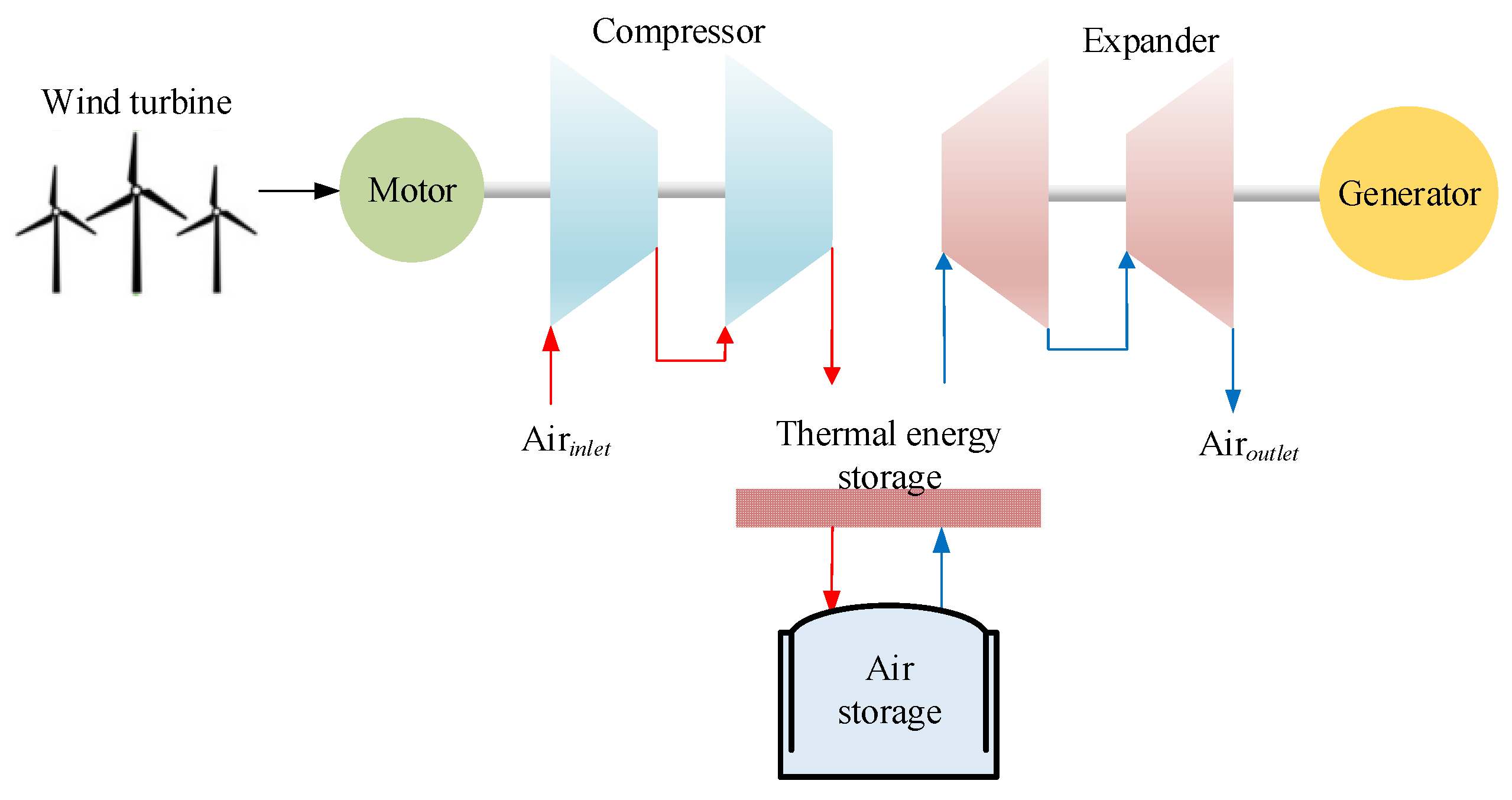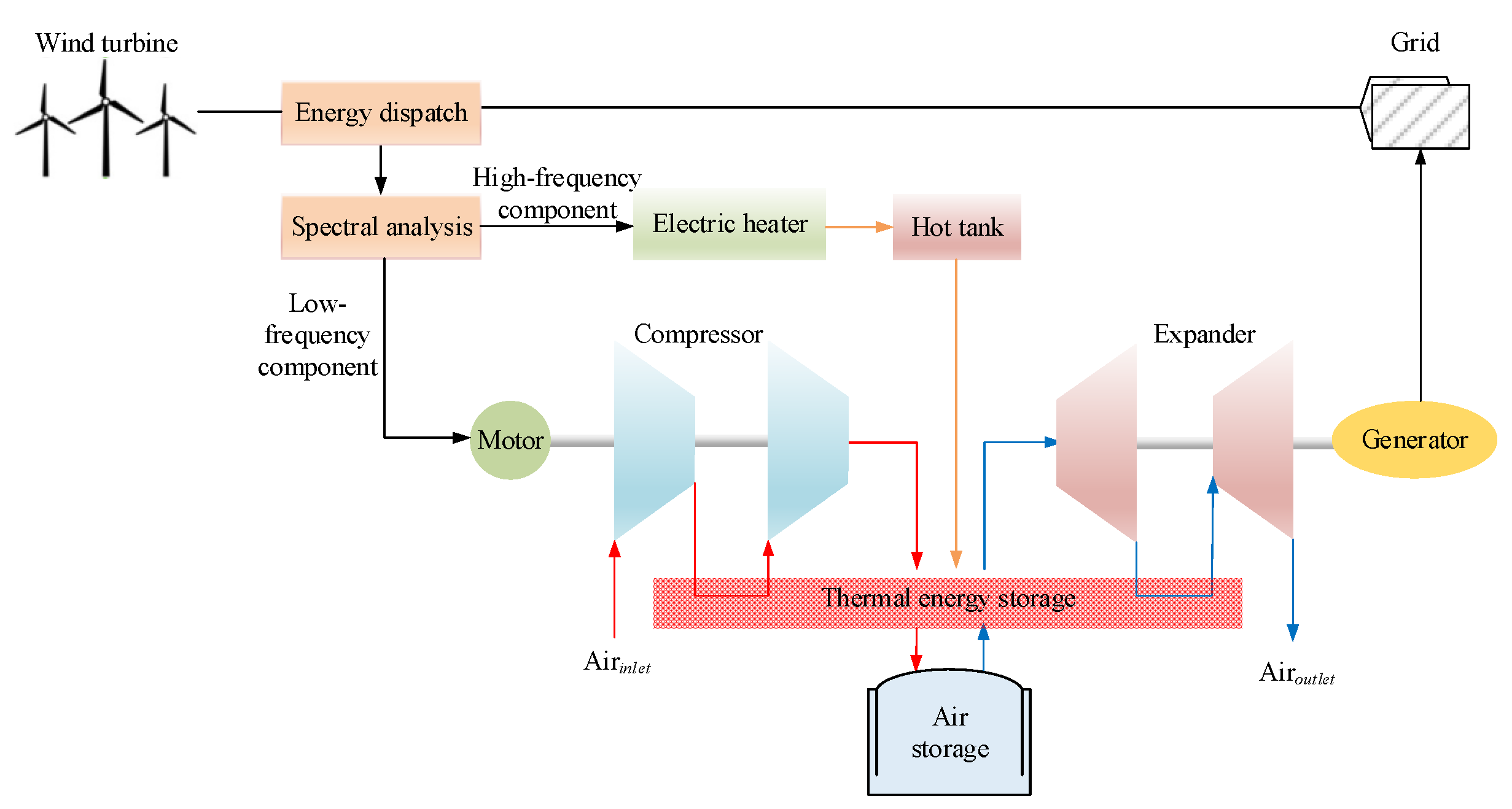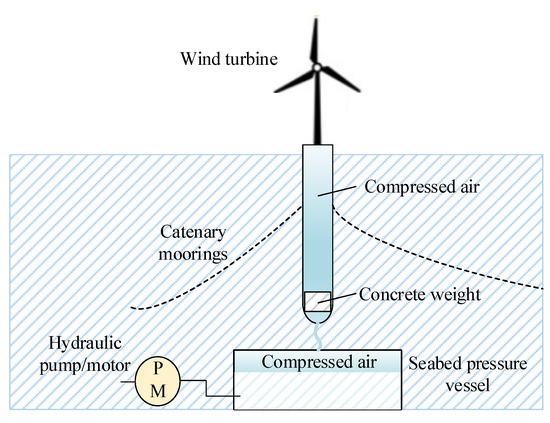Your browser does not fully support modern features. Please upgrade for a smoother experience.

Submitted Successfully!
Thank you for your contribution! You can also upload a video entry or images related to this topic.
For video creation, please contact our Academic Video Service.
| Version | Summary | Created by | Modification | Content Size | Created at | Operation |
|---|---|---|---|---|---|---|
| 1 | Yujie Xu | -- | 1693 | 2023-06-27 05:20:51 | | | |
| 2 | Conner Chen | Meta information modification | 1693 | 2023-06-29 07:29:39 | | |
Video Upload Options
We provide professional Academic Video Service to translate complex research into visually appealing presentations. Would you like to try it?
Cite
If you have any further questions, please contact Encyclopedia Editorial Office.
Guo, H.; Kang, H.; Xu, Y.; Zhao, M.; Zhu, Y.; Zhang, H.; Chen, H. CAES Systems Coupled with Wind Energy. Encyclopedia. Available online: https://encyclopedia.pub/entry/46088 (accessed on 14 January 2026).
Guo H, Kang H, Xu Y, Zhao M, Zhu Y, Zhang H, et al. CAES Systems Coupled with Wind Energy. Encyclopedia. Available at: https://encyclopedia.pub/entry/46088. Accessed January 14, 2026.
Guo, Huan, Haoyuan Kang, Yujie Xu, Mingzhi Zhao, Yilin Zhu, Hualiang Zhang, Haisheng Chen. "CAES Systems Coupled with Wind Energy" Encyclopedia, https://encyclopedia.pub/entry/46088 (accessed January 14, 2026).
Guo, H., Kang, H., Xu, Y., Zhao, M., Zhu, Y., Zhang, H., & Chen, H. (2023, June 27). CAES Systems Coupled with Wind Energy. In Encyclopedia. https://encyclopedia.pub/entry/46088
Guo, Huan, et al. "CAES Systems Coupled with Wind Energy." Encyclopedia. Web. 27 June, 2023.
Copy Citation
With the strong advancement of the global carbon reduction strategy and the rapid development of renewable energy, compressed air energy storage (CAES) technology has received more and more attention for its key role in large-scale renewable energy access. It is shown that the coupling of wind energy and CAES is mainly combined in series and in parallel, and sometimes part of the wind power can be converted into thermal energy when coupled to CAES.
compressed air energy storage
renewable energy
coupling
1. CAES Systems Coupled with Wind Energy
Many scholars have studied the characteristics of the coupling system of wind power and CAES. Wind-power-connecting CAES has two topological structures of series and parallel connections. In series CAES, during energy storage periods, absorbs all the wind power [1], and then CAES outputs stable electrical energy during the energy release period. When in parallel connection CAES, under energy storage conditions, absorbs the low-valley electricity from the power grid, and then outputs electricity to supplement wind power, making the overall output relatively stable [2][3]. Further applications are a combination of series and parallel connections, so that CAES and wind power are in series during energy storage (absorbing the part of the wind power that exceeds the dispatch), and so that CAES and wind power are connected in parallel when energy is released (smoothly outputting power and increasing the total amount of wind power) [4]. In addition to the power coupling between wind power and CAES, some scholars have studied thermoelectric coupling and mechanical coupling [5][6][7], but there are fewer studies of these aspects. Research progress on coupling methods is described in detail below.
2. Wind Power Connecting to CAES in Series
A coupling system of wind power connecting with A-CAES in series has been studied by Zhang et al. [1], as shown in Figure 1. The impacts of stable and unstable wind speed on the coupling system were analyzed and compared for energy conversion efficiency and system efficiency in Zhang’s work. It was found that the strength and fluctuation of wind speed have an evident impact on the energy conversion efficiency of each part of the coupling system. The existence of a properly stable wind speed makes better use of wind energy with the high efficiency of the coupling system, which is based on both the energy conversion efficiency of the wind turbine and the A-CAES system being relative high.

Figure 1. Schematic diagram of coupling system of wind power connecting with A-CAES in series.
Meng et al. [8] studied a system where wind power was connected to a conventional CAES compressor directly, and considered the off-design characteristics of the components. The results show that the CAES system at a variable shaft speed mode can utilize more excess wind energy, store more compressed air, generate more electricity, and provide a longer discharging time than that at a constant shaft speed mode. It was also found that the levelized cost of electricity (LCOE) at a variable shaft speed mode is lower than that at a constant shaft speed mode. Ghorbani et al. [9] also studied coupling systems connected in series. The work presented a recovery approach by using phase change material (PCM) thermal storage as a case study. Studies have shown that the system can be more efficient, sustainable, and reduce irreversibility after using phase change heat storage. The system energy efficiency and exergy efficiency can reach 70.83 and 80.71%. Abouzeid et al. [10] presented a cooperative control framework of a wind energy conversion system (WECS) directly connected to CAES. The proposed coordination scheme aimed to solve the contradiction between the speed regulation system and the frequency modulation signal in WECS. The results confirm that the proposed coordination can improve the frequency response of the system compared to the non-coordinated control operation.
3. Wind Power Connecting to CAES in Parallel
The research concerning wind power connecting to CAES only in parallel is limited. Hasan et al. [2] proposed a parallel connection of the CAES system with a wind turbine to provide continuous electricity to the grid system and to reduce wind power fluctuations. The results show that a parallel CAES system and wind power are able to smooth out wind power fluctuations and to provide continuous power to the grid system with low power consumption.
4. Wind Power Connecting to CAES in Series and in Parallel
Succar et al. [11] studied the scheduling problem when wind power is combined with CAES in series and in parallel. The system flowchart is shown in Figure 2. Studies have shown that the comprehensive optimization of wind storage systems can significantly reduce LCOE. These changes increase the capacity factor of a wind farm. Meanwhile, the coupling method reduces the storage capacity requirements of the base load plant, and reduces the GHG emission rate of the combined system compared to the coupling of the wind farm to CAES by optimizing the wind farm alone. Sriyakul et al. [3] studied the dispatch of a similar combined system considering economic risks. The system participated in three markets, including day-ahead, intraday, and balancing markets. The downside risk constraint method (DRCA) was modeled using stochastic formulas to enable better management of financial risk. The strategy proposed by DRCA is less profitable (1.97%), but brings a guaranteed risk control strategy to the power aggregator, and the risk is reduced by 100%.

Figure 2. Schematic diagram of coupling system of wind power connecting with A-CAES in series and in parallel.
5. Wind Power and Wind Heat Connecting to CAES
In addition to driving the compressor, high-frequency wind power fluctuations are also converted into resistance heat to heat the inlet of the expander and increase output power. This way, CAES can absorb more fluctuate wind power compared to a situation where wind power only drives the compressor. Yang et al. [12] studied a coupling CAES system for the hybrid use of wind power, as shown in Figure 3. Wind power not only drives the compressor, but also uses a resistance wire to heat the thermal storage device to increase power output and wind energy utilization. A theoretical thermodynamic analysis shows that the coupling CAES system has a stronger ability to absorb thermal energy than the A-CAES system, with the same compressors, thermal energy storage (TES) units, and turbines of the same size. Based on the final storage temperature of TES, the recovery efficiency of this additional wind power is about 41–47%.

Figure 3. Schematic diagram of a coupled system combining wind power, wind heat, and CAES.
Zhao et al. [13][14] also proposed a similar coupling system, in which the low-frequency part of the wind energy drives the compressor and the high-frequency part of the energy uses the resistance wire to heat the expander inlet to improve the output. Meanwhile, two sets of compressors/expanders of different powers are equipped to ensure the wide operating conditions of the system. The simulation results show that one of the more effective ways to eliminate fluctuations in wind power generation is the CAES system with a dual-power-level turbo machinery structure.
6. Other Coupling Types
The coupling of wind power and CAES also includes other forms, such as mechanical coupling. Sun et al. [15] proposed a mechanical coupling system of CAES and wind turbines, as shown in Figure 4. A prototype test bench was established to enable this mechanism. Through simulation and experimental research, the energy conversion efficiency of the system under different working conditions and different modes was analyzed. The proposed system is proved to be technically feasible, with an energy efficiency around 50%. Due to the capacity of typical scroll expanders, the proposed system is only suitable for small-scale wind energy utilization systems.

Figure 4. Schematic diagram of a mechanical coupling system of CAES and wind turbines.
Sant et al. [6] coupled CAES and wind energy into a structure, presenting a concept for integrating CAES into spar-type floating wind turbine platforms, as shown in Figure 5. The system uses a hydraulic pump and turbine to complete the power transfer. The results were compared to those derived from a conventional floating offshore wind turbine (FOWT)-spar configuration without an energy storage system. Although integrating CAES into floating beams leads to a significant increase in the weight of the floating structures, studies have shown that the integration of short-term energy storage capabilities in the order of megawatt-hours is technically feasible.

Figure 5. CAES concept integrated into a FOWT spar-type structure.
Saadat et al. [16] proposed a compressor air–hydraulic energy storage system, as shown in Figure 6. The system used a liquid pump/turbine for energy storage and release. A liquid piston air compressor/expander with enhanced heat transfer was developed. The enhanced heat transfer was achieved by using porous media and droplet sprays and reduced leakage. The liquid piston compressors/expanders were able to loosely maintain accumulator pressure ratios, while the down-tower hydraulic pumps/motors could accurately track the required generator power.

Figure 6. Schematic diagram of a compressor air–hydraulic energy storage system.
Wind energy connecting with CAES also can be combined with other energy systems to form large hybrid systems for grid frequency regulation [10][17], increasing the revenue from wind power operation [9], and reducing pollutant emissions [18]. Some of the relative research follows.
Li et al. [19] studied the scheduling problems which result from combining wind, gas, power systems, and traditional CAES in the presence of severe uncertainty caused by high wind power penetration. In their study, information gap decision theory was employed to depict the inherent uncertainty of wind power. The numerical test results show that after considering the demand response scheme, the total cost is reduced by 3.63%. Astolfi et al. [20] studied the design problems and coupling effects of a UW-CAES system connected to wind power for grid peak shaving and dispatch ability enhancement. They evaluated the impact of a realistic power input on system performance and plant flexibility. Based on realistic wind data and considering part-load characteristics, annual simulations show that global round-trip efficiency is around 75, and a 10–15% reduction in the average unplanned energy injection into the grid system is achieved. Rahmanifard et al. [18] evaluated the role of CAES in district energy systems. Using CMG STARS, they developed a model to simulate the performance of CAES-geothermal power plants with or without wind power in a typical hot and dry rock reservoir. Studies have shown that wind/CAES-geothermal schemes have the lowest LCOE (7.8–11.8¢/kWh) and an emission intensity of 88–126 g CO2/kWh.
References
- Zhang, Y.; Yang, K.; Li, X.; Xu, J. Thermodynamic analysis of energy conversion and transfer in hybrid system consisting of wind turbine and advanced adiabatic compressed air energy storage. Energy 2014, 77, 460–477.
- Hasan, N.S.; Hassan, M.Y.; Abdullah, H.; Rahman, H.A.; Omar, W.Z.W.; Rosmin, N. Improving power grid performance using parallel connected Compressed Air Energy Storage and wind turbine system. Renew. Energy 2016, 96, 498–508.
- Sriyakul, T.; Jermsittiparsert, K. Risk-controlled economic performance of compressed air energy storage and wind generation in day-ahead, intraday and balancing markets. Renew. Energy 2021, 165, 182–193.
- Zhao, P.; Xu, W.; Zhang, S.; Wang, J.; Dai, Y. Technical feasibility assessment of a standalone photovoltaic/wind/adiabatic compressed air energy storage based hybrid energy supply system for rural mobile base station. Energy Convers. Manag. 2020, 206, 112486.
- Mohammadi, A.; Ahmadi, M.H.; Bidi, M.; Joda, F.; Valero, A.; Uson, S. Exergy analysis of a Combined Cooling, Heating and Power system integrated with wind turbine and compressed air energy storage system. Energy Convers. Manag. 2017, 131, 69–78.
- Sant, T.; Buhagiar, D.; Farrugia, R.N. Evaluating a new concept to integrate compressed air energy storage in spar-type floating offshore wind turbine structures. Ocean Eng. 2018, 166, 232–241.
- Sant, T.; Buhagiar, D.; Farrugia, R.N. Modelling the Dynamic Response and Loads of Floating Offshore Wind Turbine Structures with Integrated Compressed Air Energy Storage. In Proceedings of the ASME 2017 36th International Conference on Ocean, Offshore and Arctic Engineering, Trondheim, Norway, 25–30 June 2017.
- Meng, H.; Wang, M.; Olumayegun, O.; Luo, X.; Liu, X. Process design, operation and economic evaluation of compressed air energy storage (CAES) for wind power through modelling and simulation. Renew. Energy 2019, 136, 923–936.
- Ghorbani, B.; Mehrpooya, M.; Ardehali, A. Energy and exergy analysis of wind farm integrated with compressed air energy storage using multi-stage phase change material. J. Clean. Prod. 2020, 259, 120906.
- Abouzeid, S.I.; Guo, Y.; Zhang, H.-C. Cooperative control framework of the wind turbine generators and the compressed air energy storage system for efficient frequency regulation support. Int. J. Electr. Power Energy Syst. 2021, 130, 106844.
- Succar, S.; Denkenberger, D.C.; Williams, R.H. Optimization of specific rating for wind turbine arrays coupled to compressed air energy storage. Appl. Energy 2012, 96, 222–234.
- Yang, Z.; Wang, Z.; Ran, P.; Li, Z.; Ni, W. Thermodynamic analysis of a hybrid thermal-compressed air energy storage system for the integration of wind power. Appl. Therm. Eng. 2014, 66, 519–527.
- Zhao, P.; Wang, P.; Xu, W.; Zhang, S.; Wang, J.; Dai, Y. The survey of the combined heat and compressed air energy storage (CH-CAES) system with dual power levels turbomachinery configuration for wind power peak shaving based spectral analysis. Energy 2021, 215, 119167.
- Zhao, P.; Gou, F.; Xu, W.; Shi, H.; Wang, J. Multi-objective optimization of a hybrid system based on combined heat and compressed air energy storage and electrical boiler for wind power penetration and heat-power decoupling purposes. J. Energy Storage 2023, 58, 106353.
- Sun, H.; Luo, X.; Wang, J. Feasibility study of a hybrid wind turbine system—Integration with compressed air energy storage. Appl. Energy 2015, 137, 617–628.
- Saadat, M.; Shirazi, F.A.; Li, P.Y. Modeling and control of an open accumulator Compressed Air Energy Storage (CAES) system for wind turbines. Appl. Energy 2015, 137, 603–616.
- Zhang, X.; Chen, H.; Xu, Y.; Zhou, X.; Guo, H. Isothermal Compressed Air Energy Storage. In Energy Engineering, Compressed Air Energy Storage: Types, Systems and Applications; Institution of Engineering and Technology: London, UK, 2021; pp. 29–54.
- Rahmanifard, H.; Plaksina, T. Hybrid compressed air energy storage, wind and geothermal energy systems in Alberta: Feasibility simulation and economic assessment. Renew. Energy 2019, 143, 453–470.
- Li, Y.; Wang, J.; Han, Y.; Zhao, Q.; Fang, X.; Cao, Z. Robust and opportunistic scheduling of district integrated natural gas and power system with high wind power penetration considering demand flexibility and compressed air energy storage. J. Clean. Prod. 2020, 256, 120456.
- Astolfi, M.; Guandalini, G.; Belloli, M.; Hirn, A.; Silva, P.; Campanari, S. Preliminary Design and Performance Assessment of an Underwater Compressed Air Energy Storage System for Wind Power Balancing. J. Eng. Gas Turbines Power 2020, 142, 091001.
More
Information
Subjects:
Energy & Fuels
Contributors
MDPI registered users' name will be linked to their SciProfiles pages. To register with us, please refer to https://encyclopedia.pub/register
:
View Times:
1.1K
Revisions:
2 times
(View History)
Update Date:
29 Jun 2023
Notice
You are not a member of the advisory board for this topic. If you want to update advisory board member profile, please contact office@encyclopedia.pub.
OK
Confirm
Only members of the Encyclopedia advisory board for this topic are allowed to note entries. Would you like to become an advisory board member of the Encyclopedia?
Yes
No
${ textCharacter }/${ maxCharacter }
Submit
Cancel
Back
Comments
${ item }
|
More
No more~
There is no comment~
${ textCharacter }/${ maxCharacter }
Submit
Cancel
${ selectedItem.replyTextCharacter }/${ selectedItem.replyMaxCharacter }
Submit
Cancel
Confirm
Are you sure to Delete?
Yes
No




